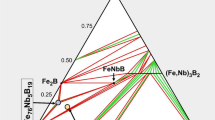Abstract
The phase composition, structure, and properties of iron-titanium antifriction alloy sintered in the ammonia plasma of a glow discharge are studied. The effect of parameters of the sintering process on the structure and properties of the alloy is determined.
Similar content being viewed by others
References
I. M. Fedorchenko, I. N. Frantsevich, I. D. Radomysel’skii, and M. S. Koval’chenko, Powder Metallurgy. Materials, Technology, Properties, and Fields of Application [in Russian], Naukova Dumka, Kiev (1985).
A. A. Nuzhdin, “Powder materials under conditions of friction and wear,” Itogi Nauki Tekh. VINITI, Ser. Poroshk. Metallurg., No. 4, 3–63 (1990).
Minabe Akira, Suganuma Tetsuya, Fukudzawa Yosita, et al., “An antifriction part with high wear resistance at elevated temperatures, Japan Appl. No. 60224760, MKI4 C22C 38/22, C23C 8/10, Toeta Dzidosi k.k. No. 59-80810, appl. 21.04.84,” Issued 09.11.85 (RZhMet, 12E 133P, 1986).
Matsumoto Syudzi and Toke Sibaura, “A method for fabricating powder wear-resistant articles, Japan Appl. No. 5920446, MKI4 C22C 22/02, B22 1/00, Denki k.k. No 57-1278874, appl. 22.07.82,” Issued 02.02.84 (RZhMet, 1E 81P, 1985).
S. V. Matrenin, A. I. Slosman, and Yu. V. Myachin, “Electric discharge sintering of an iron-titanium antifriction alloy,” Izv. Tomsk Politekh. Univ., No. 4, 74–78 (2005).
D. P. Uskovich, G. V. Samsonov, and M. M. Ristich, Activated Sintering, Electronics Faculty, NISh and Int. Inst. of the Sintering Science, Beograd (1974).
A. I. Slosman and S. V. Matrenin, “Electric discharge sintering of zirconia-based ceramics,” Ogneupory, No. 9, 24–27 (1994).
Yu. E. Kreindel’, N. M. Lemeshev, and A. I. Slosman, “Effect of hollow cathode in nitriding in glow discharge,” Élektron. Obrab. Mater., No. 6, 53–56 (1990).
Hydrogen Treatment of Materials, Coll. Inf. Mater. of the 1st, 2nd, and 3rd Int. Conf. “HTM-95,” “HTM-98,” and “HTM-2001” [in Russian], Donetsk (1995, 1998, 2001).
V. A. Goltsov, “Hydrogen treatment (processing) of materials: current status and progress,” J. Alloys Comp., 293–295, 844–857 (1999).
L. I. Kivalo, N. F. Grigorenko, and V. V. Skorokhod, “Contact interaction between liquid and sold phases in a titanium-iron dispersed system,” Poroshk. Metall., No. 9, 25–28 (1988).
G. E. Bokii, Crystal Chemistry [in Russian], Nauka, Moscow (1971).
Author information
Authors and Affiliations
Additional information
__________
Translated from Metallovedenie i Termicheskaya Obrabotka Metallov, No. 6, pp. 17–20, June, 2007.
Rights and permissions
About this article
Cite this article
Matrenin, S.V., Slosman, A.I. & Myachin, Y.V. Sintering of Fe-Ti alloy in the ammonia plasma of a glow discharge. Met Sci Heat Treat 49, 293–296 (2007). https://doi.org/10.1007/s11041-007-0052-3
Issue Date:
DOI: https://doi.org/10.1007/s11041-007-0052-3



